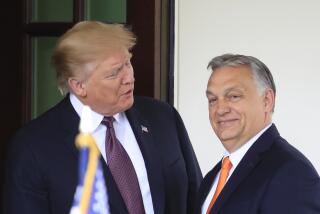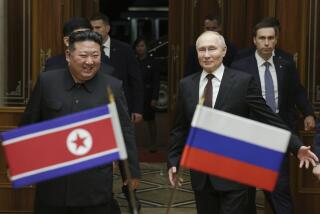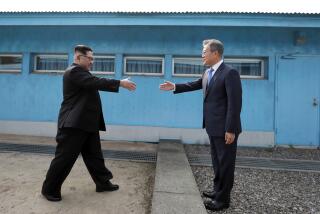Heightened tensions over North Korea and trade will define Trump’s tour of Asia
Nearly three months after threatening to destroy North Korea with “fire and fury like the world has never seen,” President Trump is getting a firsthand look at the nations most at risk from the nuclear brinkmanship, and hearing from leaders on their own soil.
During 10 days in Asia, Trump will go within 35 miles of North Korea, the long-isolated nation governed by the mysterious and volatile Kim Jong Un, whose nuclear ambitions have been the most pressing national security concern of Trump’s term.
“North Korea is going to be the question that is on everyone’s mind,” said Michael J. Green, an Asia analyst in the George W. Bush administration, now senior vice president for Asia and Japan at the Center for Strategic and International Studies.
That’s for good reason, Green continued: “The North Koreans are rushing towards the end zone — towards the goal line of getting nuclear warheads that can be mounted on intercontinental ballistic missiles, launched at the U.S., survive reentry into the atmosphere, and then blow up somewhere.”
Trump, who leaves Hawaii for the region on Saturday, will visit five nations: Japan, South Korea and China — the three with the most at stake regarding North Korea — as well as Vietnam and the Philippines. It is a tour that will require him to perform a perhaps impossible balancing act: seeking more help, especially from China, in pressuring North Korea while also pressing for trade concessions.
Trump’s national security advisor, H.R. McMaster, said the president would carry a blunt message, about North Korea in particular.
“China recognizes this isn’t the United States or anyone else asking China to do us a favor,” he said. “China recognizes it is clearly in China’s interest and all nations’ interest to denuclearize the peninsula.”
Trump’s first trip to the region as president will include not only talks with foreign leaders on security and trade, but also lavish state dinners, opulent ceremonies and at least one round of golf-course diplomacy.
Because Trump’s itinerary includes several summits that draw additional nations’ heads of state, there may be a few wild cards, including a potential meeting with Russian President Vladimir Putin — at a time when a special counsel’s investigation into the Trump campaign’s alleged ties to Russian meddling in the U.S. election has yielded its first indictments of Trump associates.
Trump is scheduled to meet with another controversial leader, Philippines President Rodrigo Duterte. The two have “a warm rapport,” an administration official said, though Duterte stands accused of allowing death squads to kill more than 6,000 people in his government’s war on drugs.
The trip is Trump’s fourth abroad as president and perhaps the toughest test yet of his acumen on a world stage before foreign leaders skeptical of his leadership, confused by his mixed messages and worried about his impulsive behavior.
Asia trips are famously grueling, given the long flights and time difference. Add to that Trump’s age, 71, his preference for his own bed, and his concern with the ongoing investigation at home. The last president to spend so many days on an Asian journey, George H.W. Bush, vomited on the Japanese prime minister at a dinner at his trip’s end.
Missteps could set off unintended consequences, especially considering Trump’s past war of words with North Korea’s Kim and that regime’s propensity to rattle its neighbors with nuclear and missile tests.
“If words are to count, the administration has boxed itself in, in very, very significant ways,” said Jonathan D. Pollack, a Brookings Institution scholar and former director of its China Center.
Asian leaders remain confused over Trump’s posture toward North Korea. Secretary of State Rex Tillerson, Defense Secretary James N. Mattis and others have emphasized the administration’s desire for a diplomatic solution, though Trump has publicly declared that Tillerson was “wasting his time” talking to North Korea and insisted the United States is “locked and loaded” to confront it.
Asians “find him unpredictable,” said Wendy Cutler, who has led trade negotiations for Presidents George W. Bush and Barack Obama and is now vice president of the Asia Society Policy Institute. “A lot of countries are very wary that even if they feel like they’re getting along with the Trump administration, they don’t know what lies in the future.”
Administration officials have downplayed expectations for major deals on trade or security. Instead, they are emphasizing the symbolic value of reassuring allies that the United States remains a strong ally against North Korea and — despite Trump’s early abandonment of the Trans-Pacific Partnership, which is popular in the region — a trade partner still interested in strong ties, just more on U.S. terms.
China sits at the strategic center of both goals, as Trump works to simultaneously persuade the nation to back tougher sanctions on North Korea, which is reliant on Beijing for support and trade, while assuring allies that the United States will not allow China to dominate the region.
“There are real concerns right now” among Asian allies about how the U.S. will approach China and the rest of the region, said Scott Mulhauser, who was chief of staff for the U.S. Embassy in Beijing under Obama.
China is eager to flex its muscle. Beijing is trying to move into the economic power vacuum created by Trump’s withdrawal from the TPP, which was a 12-nation Pacific Rim trade agreement negotiated by the Obama administration. In addition, President Xi Jinping recently won extraordinary powers that make him the most dominant figure in China since Mao Tse-tung.
After castigating Xi and Chinese trade “cheating” throughout his campaign, Trump has softened to calling Xi a friend and partner since the two met at an April summit at Trump’s Mar-a-Lago resort in Florida. In a recent interview with Fox Business News, Trump sounded enamored of Xi’s new authority: “Now, some people might call him the king of China.”
Xi and Japanese Prime Minister Shinzo Abe have both courted Trump aggressively, seeing such overtures to the proud president as key to better policy outcomes.
Abe, whom Trump golfed with at Mar-a-Lago in February, plans on returning the favor when Trump visits Japan. And China’s ambassador to the United States, Cui Tiankai, heralded Trump’s arrival as a “state visit-plus” in a recent interview with reporters, suggesting extra pageantry befitting the “historic moment.”
“I have no doubt Trump will be shown a grand time,” said the Brookings Institution’s Pollack.
Behind the visuals, however, these leaders are beginning to view America as a diminished power and gaming out how they can advance their own interests, he said.
James Jay Carafano, a foreign policy and defense specialist at the conservative Heritage Foundation who has advised Trump, said the president needs to get along with Xi, without deferring to him or making allies in the region feel that they are “getting squashed between two giants.”
To date, Trump has been surprisingly pliant, though analysts give him some credit for pushing China to support tougher sanctions on North Korea.
He “has talked tough against China, but when you look at the actual track record of the last 10 months, you don’t see a lot of action or successful negotiations with China,” said Cutler.
Aides say he will avoid the Demilitarized Zone that divides North and South Korea, a traditional stop for nearly every president who has visited the peninsula, going back to Ronald Reagan.
“It creates a bit of a juxtaposition for a leader who talks tough about North Korea but opts not to travel to freedom’s frontier,” said Ryan Hass, a Brookings Institution scholar who was Obama’s National Security Council director for China, Taiwan and Mongolia.
A senior Trump advisor says the president’s time is limited and he instead will visit Camp Humphreys, a U.S. Army base, at the request of South Korean officials.
Despite concerns over Trump’s stamina on the long trip, he told reporters as he boarded Air Force One on Friday morning that he would add a day to his last stop in the Philippines, allowing him to attend the annual East Asia Summit. His prior plans to skip that conference had elicited criticism from foreign policy experts, who said his absence would be taken as a slight, and a signal of reduced U.S. engagement in the region.
Given the amount of time he will be spending there, some analysts see potential for improving America’s position in Asia. Green, the former Bush official, said Obama took about two years to refine his Asia policy.
“Presidents learn on these trips,” he said, “and they develop their policies and you see something different the next time.”
Times staff writer Brian Bennett in Washington contributed to this report.
Twitter: @noahbierman
ALSO
The first casualty of North Korean nuclear tests? The country’s environment
UPDATES:
8:37 a.m.: The article was updated to reflect that Trump is extending his trip by a day.
This article was originally published at 3 a.m.
More to Read
Get the L.A. Times Politics newsletter
Deeply reported insights into legislation, politics and policy from Sacramento, Washington and beyond. In your inbox three times per week.
You may occasionally receive promotional content from the Los Angeles Times.











